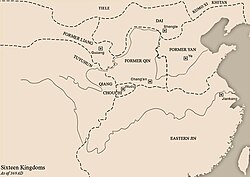
Back Mujong Catalan Frühere Yan German Mujong Spanish یان سابق Persian Yan antérieur French Chhièn-Yèn HAK Raniji Yan Croatian Yan Awal ID 前燕 Japanese 전연 Korean
Yan 燕 | |||||||||||||||
|---|---|---|---|---|---|---|---|---|---|---|---|---|---|---|---|
| 337–370 | |||||||||||||||
 Former Yan in 338 AD | |||||||||||||||
 Former Yan in 369 AD | |||||||||||||||
| Capital | Jicheng (棘城) (337–342) Longcheng (342–350) Jicheng (薊城) (350–357) Yecheng (357–370) | ||||||||||||||
| Government | Monarchy | ||||||||||||||
| Emperor | |||||||||||||||
• 337–348 | Murong Huang | ||||||||||||||
• 348–360 | Murong Jun | ||||||||||||||
• 360–370 | Murong Wei | ||||||||||||||
| History | |||||||||||||||
• Murong Huang's claim of princely title | 23 November 337[1][2] 337 | ||||||||||||||
• Murong Jun's claim of imperial title | 4 January 353[3][4] | ||||||||||||||
• Fall of Yecheng | 11 December 370[5][6] | ||||||||||||||
• Disestablished | 370 | ||||||||||||||
| |||||||||||||||
| Today part of | China | ||||||||||||||
Yan, known in historiography as the Former Yan (Chinese: 前燕; pinyin: Qián Yān; 337–370), was a dynastic state of China ruled by the Murong clan of the Xianbei during the Sixteen Kingdoms period.
Initially, Murong Huang and his son Murong Jun claimed the Eastern Jin-created title "Prince of Yan", but subsequently, in 352, after seizing most of the former Later Zhao territory, Murong Jun would declare himself emperor, and after that point, the rulers of the Former Yan declared themselves "emperors".
- ^ "兩千年中西曆轉換". Sinica.edu.tw. Retrieved 2011-08-03.
- ^ Zizhi Tongjian, vol. 95.
- ^ "兩千年中西曆轉換". Sinica.edu.tw. Retrieved 2011-08-03.
- ^ Zizhi Tongjian, vol. 99.
- ^ "兩千年中西曆轉換". Sinica.edu.tw. Retrieved 2011-08-03.
- ^ Zizhi Tongjian, vol. 102.
© MMXXIII Rich X Search. We shall prevail. All rights reserved. Rich X Search